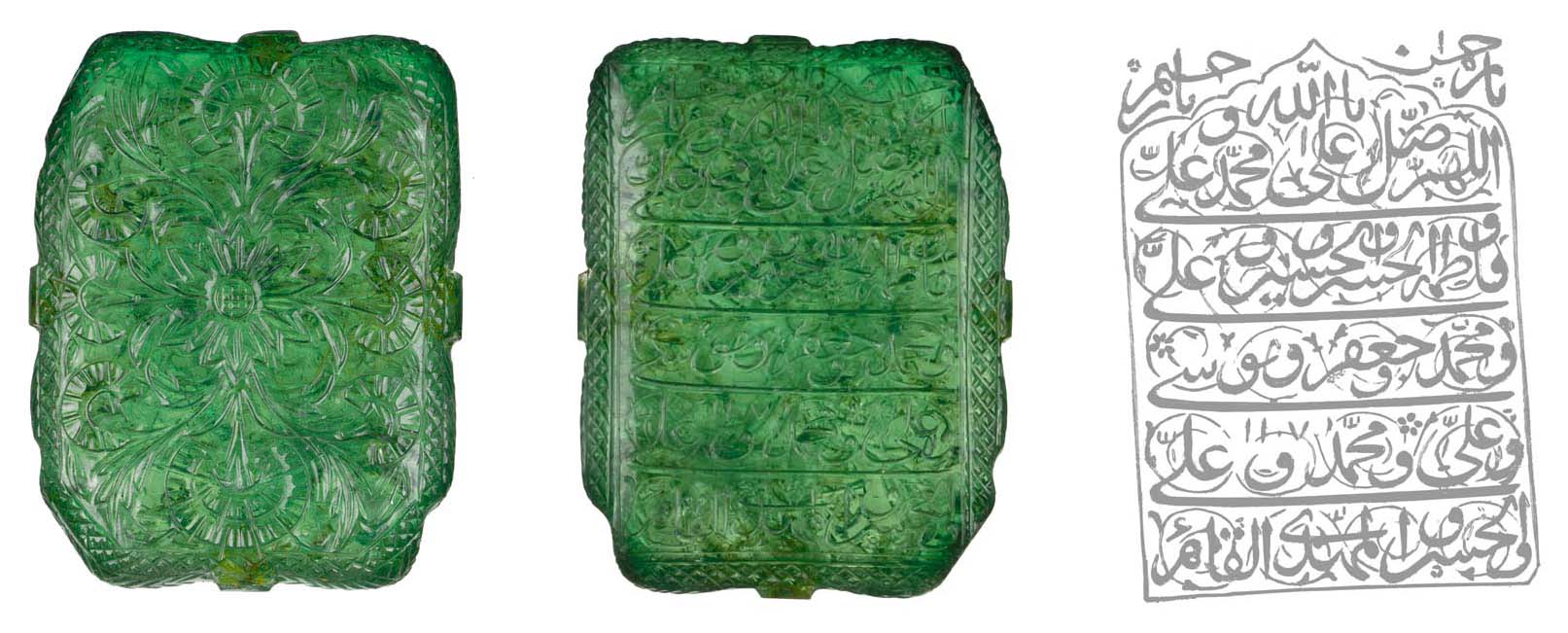
A magnificent emerald carved with a Shi`ite invocation; Deccani?, 1695/6
Source: http://www.christies.com/LotFinder/search/LotDetail.asp?intObjectID=2729922&SE=CMWCAT02+44450+%2D1485617171+&QR=M+1+7+Aqc0000900+43972++Aqc0000900+&entry=islamic&RQ=False&AN=8
(downloaded Sept. 2001)
"A MAGNIFICENT CARVED EMERALD, Mughal or Deccani, dated AH 1107/1695-6 AD. The rectangular-cut emerald known as 'The Mogul Mughal' weighing 217.80 carats, the obverse engraved with Shi'a invocations in elegant naskh script, dated 1107 A.H., the reverse carved all over with foliate decoration, the central rosette flanked by single large poppy flowers, with a line of three smaller poppy flowers either side, the bevelled edges carved with cross pattern incisions and herringbone decoration, each of the four sides drilled for attachments, 2 1/16 x 1 9/16 x 7/16 in. (5.2 x 4x 1.2 cm.)
Literature:
Stuart Cary Welch, India, Art and Culture 1300-1900, The Metropolitan
Museum of Art, New York, 1985, p. 273
Gems & Gemology, The Gemolgical Institute of America, Volume XVII,
Summer 1981
Exhibited:
Washington, D.C., Smithsonian Institution, July - December 1995.
New York, NY., Metropolitan Museum of Art, India: 1300 AD - 1900
AD, 14 September 1985 - 5 January 1986
New York, NY., American Museum of Natural History, 14 October 1983
- 13 January 1984
Los Angeles, CA., Los Angeles County Museum of Natural History, Pre-Colombian
Gold and Emeralds, 4 July - 6
September 1981
Lot Notes:
The inscription contains a Shi'a prayer blessing Muhammad and the twelve
Imams; and the hijra date 1107 which transposes to 1695 -96 A.D.
In full it reads:
O Merciful One, O Compassionate One
O God
God bless Muhammad and 'Ali
and Fatima and al-Husain
and al-Hasan and 'Ali
and Muhammad and Ja'far
and Musa
1107
and 'Ali and Muhammad
and 'Ali
and al-Husaini and the steadfast Mahdi
This is the only known carved and dated emerald of the classic Mughal period. The date places it to the reign of Emperor Aurangzeb (1658 - 1707), the last of the four great Mughal rulers who ruled between them for 150 years. This emerald is the benchmark for the dating of all other Indian carved emeralds.
Fine large emeralds were unknown until their discovery in Colombia by the Spanish Conquistadors of the 16th and 17th century. They were extremely popular in all three of the great Islamic empires of the time: the Ottoman Turks, the Safavid Persians and the Mughal Indians; so much so that none appear to have been retained at the time in Europe. They reached India via Spain as trade goods during the Mughal dynasty. They were highly prized by the Indians who used them mainly as beads or in gold artefacts.
The Mughal Emperors were Sunni and therefore the Shi'a prayer would suggest that this stone should not be associated directly with the emperor Aurangzeb himself, particularly since by this date he had become somewhat of a religious zealot. It is likely, however, that it would have belonged to one of the Emperor's officers, many of whom were of Shi'a Deccani and Persian origin. It could also have belonged to one of the great nobles of the Deccan where Shiism was the predominant sect of Islam, possibly from either Golconda or Hyderabad.
The reverse side of the emerald is carved with a central rosette, poppy flowers and scrolling foliate detail, typical of the naturalistic decoration of the period reflecting the Mughal love of nature. Worn as a talisman with the inscription facing outward, it was mounted and secured by the drill holes to each side.
Centuries of tradition have held certain precious stones to be imbued with powers radiated by celestial bodies. A logical inference was to augment this phenomenon by carving the stone with a suitable image of a deity, with symbols or with writing. In addition to this, the green colour of emerald holds a special significance within Islam; for this reason it is especially suited for engraving as a talisman. The other stone frequently used for Moslem religious inscriptions is jade, again with its variations of green colour.
Comparable stones:
Large inscribed emeralds rarely appear on the market. However, on May
12 1988 Christie's sold two carved emeralds from the Mughal period, each
inscribed with text from the Qur'an, one of 142.20 carats, (lot 703), the
other of 76.00 carats, (lot 704), both formerly from the collection of
His Royal Highness Sir Sultan Mohamed III, The Aga Khan.
The Al-Sabah collection in Kuwait includes an inscribed Royal Emerald
of 59.60 carats which is polished but not carved. It is inscribed with
the name of Nadir Shah and dated 1153 A.H. This transposes to 1740-1741
A.D., the year that Nader Shah of Persia sacked Delhi and plundered the
Mughal treasury. Two further emeralds in the same collection are each inscribed
with text from the Qur'an; one is of rectangular-cut, weighing 85.60 carats,
the other hexagonal-cut, weighing 73.20 carats.."
== Indian Routes index == Indian Routes sitemap == Glossary == FWP's main page ==